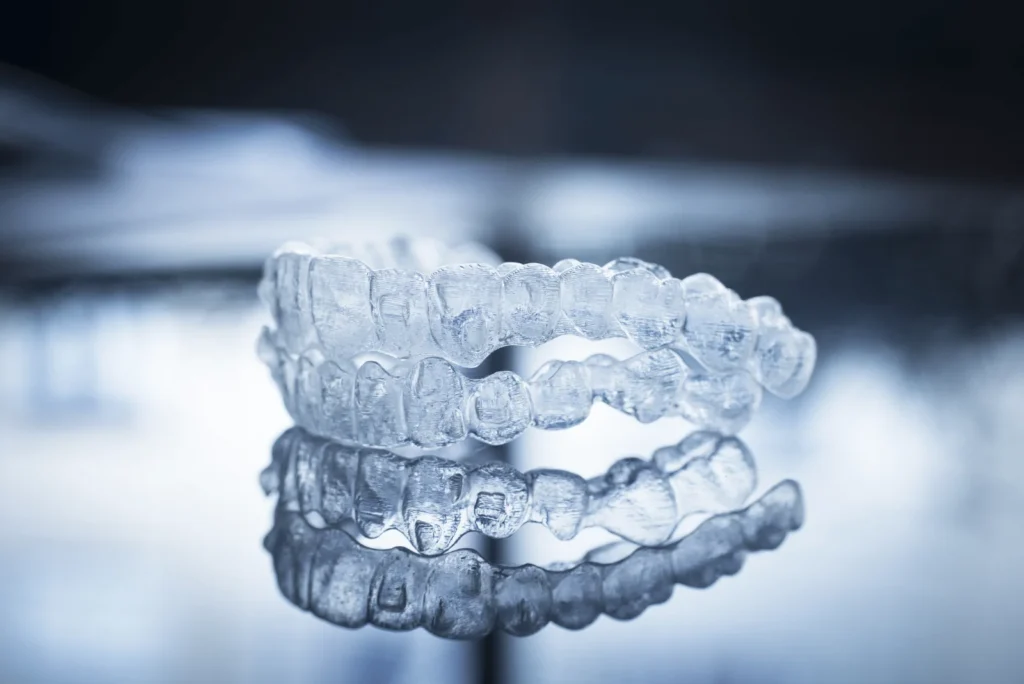Can you sleep with Invisalign, and why do I keep taking my Invisalign out in my sleep, and how can I prevent this frustrating habit from derailing my treatment progress? As a dentist at Lansdowne Family Dental with over 15 years of experience in Invisalign treatments, I regularly work with patients who struggle with unconsciously removing their aligners during the night. This common yet concerning issue can seriously compromise your treatment timeline and effectiveness, leaving many patients feeling discouraged about their orthodontic journey.
Nighttime aligner removal is more prevalent than most people realize, affecting a significant percentage of Invisalign patients at some point during their treatment. The frustration of waking up to find your aligners on the nightstand, under the pillow, or somewhere across the room is both puzzling and worrisome for patients who are committed to their treatment success.
In this comprehensive guide, I’ll explore the psychological and physiological reasons behind unconscious aligner removal, examine the various contributing factors that make this phenomenon so common, and provide you with proven, evidence-based strategies to ensure your aligners remain securely in place throughout the entire night for optimal treatment results.
Why Do I Keep Taking My Invisalign Out in My Sleep?
There are reasons to take invisalign out in sleep:
- Discomfort or Pain:
- Ill-fitting aligners can cause discomfort, leading to unconscious removal.
- New aligners may feel tight, prompting your body to seek relief during sleep.
- Pressure points on specific teeth can trigger a removal response.
- Unconscious Habit:
- If you’re used to removing aligners frequently, this habit might continue during sleep.
- Your brain may associate aligner removal with comfort, leading to unconscious actions.
- Tight Fit:
- Overly tight aligners can create pressure, leading to unconscious removal for relief.
- This is particularly common in the first few days of wearing a new set of aligners.
- Natural Jaw Movements:
- Sleep-related jaw movements can gradually dislodge aligners.
- These movements are part of normal sleep physiology and can vary in intensity from person to person.
- Stress or Anxiety:
- Increased stress can lead to restless sleep and more frequent jaw movements.
- Stress-related bruxism can exacerbate alien dislodgement.
- Dry Mouth:
- Reduced saliva flow during sleep can decrease the natural suction holding aligners in place.
- Certain medications or medical conditions can exacerbate dry mouth.

Understanding the Science Behind Nighttime Aligner Removal
To fully grasp why you might be removing your Invisalign in your sleep, it’s essential to understand the physiological changes that occur during sleep and how they affect your oral environment.
The Role of Muscle Relaxation
When you sleep, your body undergoes several physiological changes that can affect your Invisalign wear:
- Muscle Relaxation:
- All muscles, including those in your mouth and jaw, naturally relax during sleep.
- This relaxation can reduce the pressure that normally holds your aligners in place.
- The temporomandibular joint (TMJ) may slightly shift, affecting aligner fit.
- Jaw Movement:
- The lower jaw (mandible) may slightly open, reducing pressure on the aligners.
- This natural movement is part of your body’s mechanism to maintain an open airway during sleep.
- Reduced Saliva:
- Saliva production decreases during sleep, which can affect the adherence of aligners to your teeth.
- Saliva plays a crucial role in maintaining the suction that helps keep aligners in place.
Sleep Cycles and Aligner Retention
Different stages of sleep can affect aligner retention:
- REM Sleep:
- During Rapid Eye Movement (REM) sleep, muscle activity is at its lowest.
- This deep relaxation can increase the likelihood of aligners becoming loose.
- Non-REM Sleep:
- In lighter stages of sleep, you may be more prone to unconscious movements that could dislodge aligners.
Sleep Disorders and Aligner Retention
Certain sleep-related conditions can exacerbate the issue:
- Sleep Apnea:
- This condition can cause more pronounced relaxation of throat and mouth muscles.
- Frequent micro-awakenings may increase jaw movement and aligner dislodgement.
- Bruxism (Teeth Grinding):
- Nighttime grinding can put extra pressure on aligners, potentially dislodging them.
- The force from grinding may warp aligners over time, affecting their fit.
Factors Influencing Aligner Retention During Sleep: An In-Depth Analysis
There are factors influencing aligner retention during sleep:
Medications and Health Conditions
Various medications and health conditions can affect aligner retention:
- Dry Mouth-Inducing Medications:
- Antihistamines, antidepressants, and some blood pressure medications can reduce saliva production.
- This reduction in saliva can significantly affect aligner adherence.
- Hormonal Changes:
- Pregnancy, menopause, or adolescence can influence oral tissues and aligner fit.
- Hormonal fluctuations can cause temporary changes in gum tissue, affecting how aligners sit on teeth.
- Sinus Issues:
- Nasal congestion can lead to mouth breathing, which dries out the oral cavity and affects aligner retention.
- Neurological Conditions:
- Conditions like Parkinson’s disease can increase involuntary jaw movements during sleep.
Dietary Choices and Eating Habits
Your pre-bedtime routine can have a significant impact on aligner retention:
- Hot Foods and Beverages:
- Consuming hot items before bed can temporarily warp aligners.
- This warping may not be immediately noticeable but can affect fit during sleep.
- Sticky Snacks:
- These can alter aligner fit or create suction that dislodges them.
- Residue from sticky foods can interfere with the aligner’s grip on teeth.
- Acidic Foods:
- Eating acidic foods close to bedtime can temporarily soften tooth enamel, potentially affecting aligner fit.
- Hydration Levels:
- Dehydration can lead to reduced saliva production, affecting aligner adherence.
- Drinking water throughout the day, but not excessively before bed, can help maintain optimal oral hydration.
Sleep Positions and Pillow Types
Your sleeping position and pillow choice can significantly influence aligner retention:
- Side Sleeping:
- Can put pressure on one side of your mouth, potentially dislodging aligners.
- The weight of your head on the pillow can create uneven pressure on aligners.
- Stomach Sleeping:
- This position can increase jaw movement and potentially dislodge aligners.
- It may also lead to unconscious removal due to pressure on the face.
- Back Sleeping:
- Generally considered the best position for maintaining aligner position.
- Helps distribute pressure evenly across the jaw.
- Pillow Selection:
- Specialized pillows designed for dental appliances can help maintain aligner position.
- Memory foam pillows can provide better support and reduce jaw movement.
Advanced Solutions to Keep Your Invisalign in Place During Sleep
- Ensure Proper Fit with Advanced Techniques:
- Visit us at Lansdowne Family Dental for regular check-ups using 3D scanning technology to ensure precise aligner fit.
- Use “chewies” or aligner seaters before bed to ensure a snug fit, focusing on problem areas.
- Consider aligner-friendly lip balm to combat dry lips and reduce the urge to remove aligners.
- Develop a Comprehensive Nighttime Routine:
- Establish a consistent bedtime routine that includes properly seating your aligners.
- Incorporate a gentle jaw massage to relax muscles before inserting aligners.
- Use a soft-bristled toothbrush to stimulate saliva production before bed.
- Avoid eating or drinking (except water) for at least 60 minutes before bed to ensure a clean oral environment.
- Utilize Advanced Nightguard Technology:
- We can provide a custom-fitted, ultra-thin nightguard to wear over your Invisalign, keeping them secure.
- These guards can be designed with special retention features to grip aligners without interfering with treatment.
- Implement Stress-Reduction Techniques:
- Practice progressive muscle relaxation, focusing on the jaw and face muscles.
- Try guided sleep meditation specifically designed for dental patients.
- Consider cognitive behavioral therapy for sleep (CBT-I) if stress significantly affects your sleep quality.
- Optimize Your Sleep Environment:
- Invest in a humidifier to combat dry mouth during sleep.
- Use blackout curtains and white noise machines to improve sleep quality and reduce stress-related jaw clenching.
- Maintain a cool bedroom temperature (around 65°F or 18°C) to promote better sleep and reduce nighttime movement.
- Stay Hydrated with a Strategic Approach:
- Maintain good hydration throughout the day to support saliva production.
- Use a time-release oral hydration gel before bed to combat dry mouth without excessive liquid intake.
- Consider Advanced Aligner Attachments:
- We may recommend adding small, tooth-colored composite attachments to your teeth.
- These attachments can be strategically placed to provide extra grip for your aligners during sleep.
- Explore Aligner Material Options:
- Discuss the possibility of using aligners made from materials with enhanced grip properties.
- Some newer aligner materials are designed to maintain their shape and fit better during sleep.
When to Seek Professional Help: Recognizing the Signs
If you consistently find your aligners out of place in the morning, it’s crucial to consult with us at Lansdowne Family Dental. Here are some specific signs that indicate it’s time for a professional assessment:
- Frequent Displacement: If you find your aligners out of place more than once a week.
- Visible Wear: If you notice unusual wear patterns or distortions in your aligners.
- Treatment Delays: If you’re not seeing expected progress in your treatment timeline.
- Increased Discomfort: If you experience new or increased pain when wearing aligners.
- Changes in Bite: If you notice changes in how your teeth come together when biting.
During your consultation, we can:
- Perform a detailed assessment of your current aligner fit using advanced 3D scanning technology.
- Analyze your bite and jaw alignment to identify any underlying issues.
- Make necessary adjustments to your treatment plan, potentially including a rescan for new aligners.
- Explore alternative solutions, such as different aligner materials or customized attachment configurations.
- Address any underlying oral health issues that may be contributing to the problem, such as undiagnosed sleep apnea or TMJ disorders.
The Role of Technology in Aligner Retention
At Lansdowne Family Dental, we leverage cutting-edge technology to enhance your Invisalign experience:
- 3D Printing for Custom Solutions: We can create personalized aligner accessories to improve retention.
- Smart Aligner Sensors: New developments in aligner technology include small sensors that can track wear time and movement, providing valuable data for treatment optimization.
- Virtual Monitoring: We offer remote check-ins using smartphone apps, allowing us to catch and address issues quickly between in-office visits.
Lifestyle Adjustments for Optimal Aligner Wear
Making certain lifestyle adjustments can significantly improve your nighttime aligner retention:
- Evening Exercise: Gentle yoga or stretching before bed can help relax jaw muscles.
- Dietary Modifications: Consider adjusting your dinner time to allow for proper digestion before lying down, which can reduce reflux and associated jaw movements.
- Stress Management: Incorporate stress-reduction techniques into your daily routine, not just before bed.
- Sleep Hygiene: Establish a consistent sleep schedule to regulate your body’s natural rhythms.
Conclusion: Ensuring Successful Invisalign Treatment Through Comprehensive Care
At Lansdowne Family Dental, we’re committed to helping you achieve the best possible results from your Invisalign treatment. Remember, consistent wear is key to success, even during sleep. By understanding the complex factors that can lead to nighttime aligner removal and implementing the multifaceted strategies we’ve discussed, you can maximize the effectiveness of your treatment.
Your Invisalign journey is unique, and what works for one patient may not be ideal for another. That’s why we emphasize personalized care and regular check-ups. Our team at Lansdowne Family Dental is dedicated to tailoring your Invisalign treatment to your specific needs, lifestyle, and physiological factors.
If you’re experiencing issues with your Invisalign aligners or have any questions about optimizing your treatment, don’t hesitate to contact us. We’re here to support you throughout your journey to a straighter, healthier smile, providing expert guidance every step of the way.
Remember, achieving your perfect smile is a partnership between you and your dental care team. By staying informed, proactive, and in close communication with us, you’re setting yourself up for Invisalign success. Let’s work together to ensure that every night of sleep brings you closer to the smile of your dreams!






